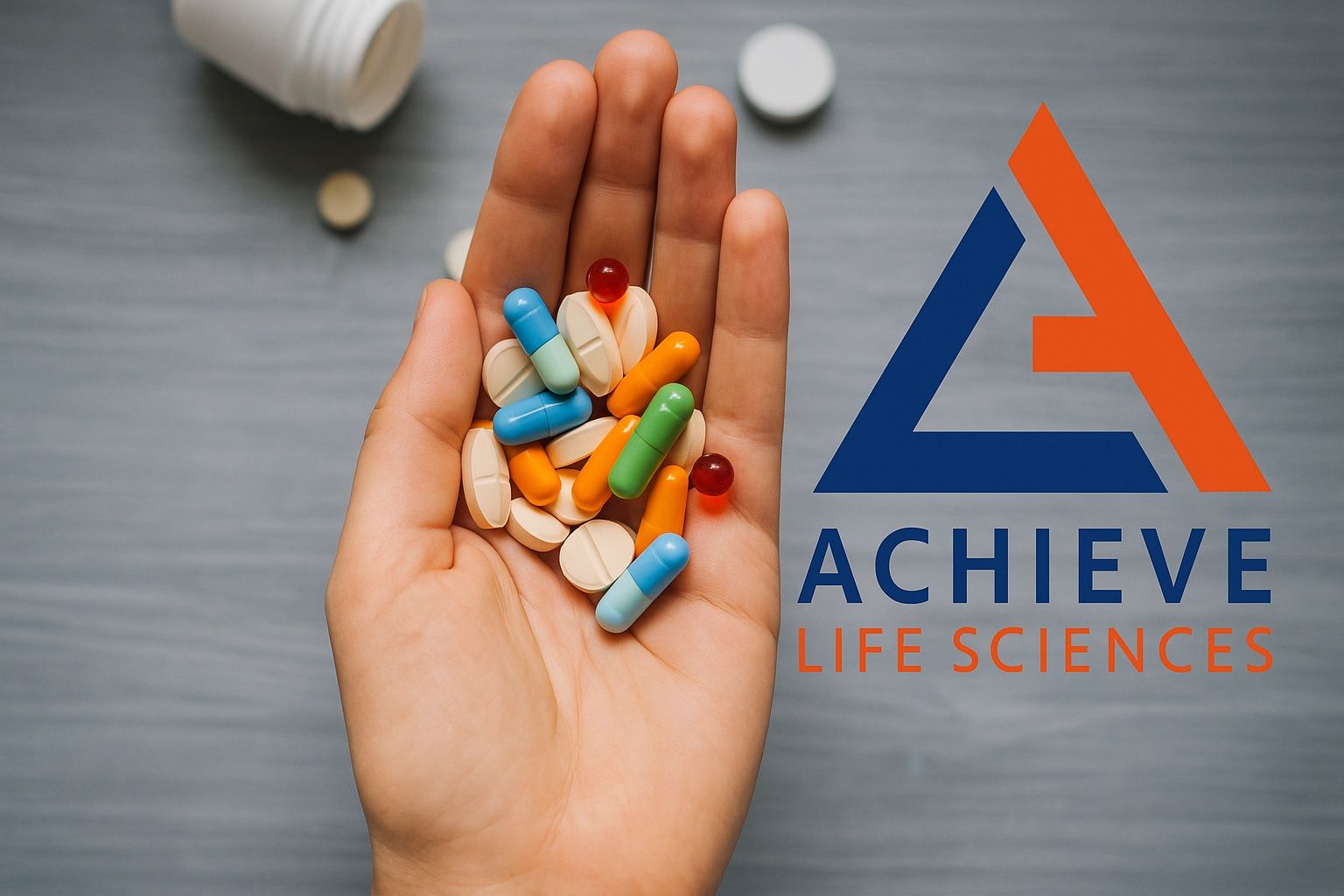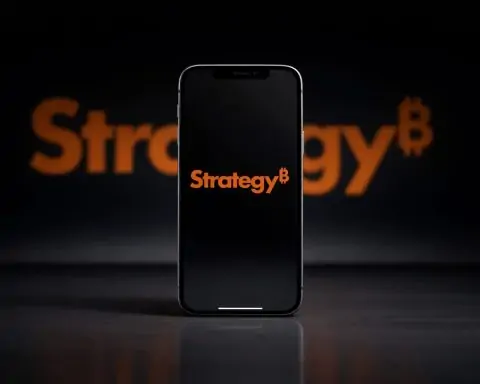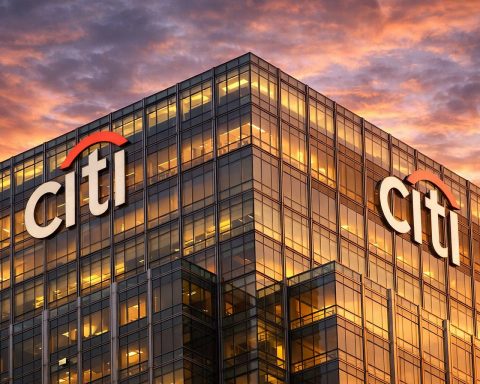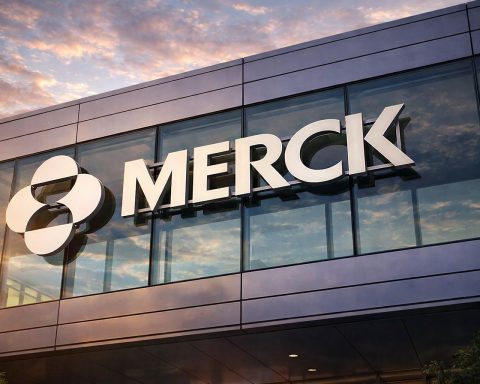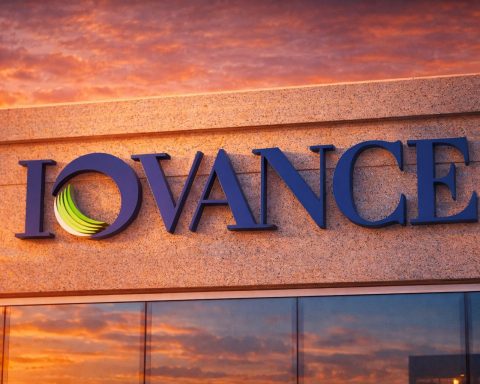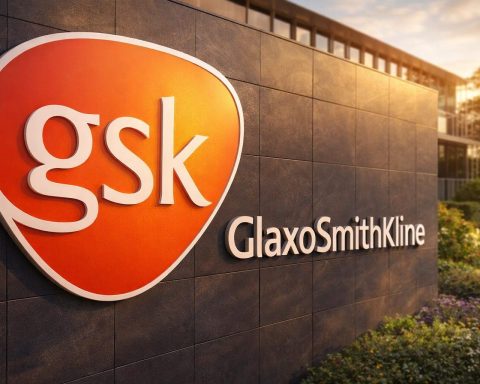- Stock Soars on FDA News: Achieve Life Sciences (NASDAQ: ACHV) shares surged over 20% in pre-market trading on Friday after announcing an unprecedented FDA Commissioner’s National Priority Voucher for its lead drug, cytisinicline [1]. The voucher promises to slash review times to as little as 1-2 months for Achieve’s vaping-cessation indication, versus the typical 10-12 months [2].
- Regulatory Milestone Reached: The FDA accepted Achieve’s New Drug Application (NDA) for cytisinicline as a treatment for smoking cessation in adults, setting a target decision date of June 20, 2026 (PDUFA) [3] [4]. If approved, it would be the first new prescription therapy for nicotine dependence in nearly 20 years [5].
- Cytisinicline – A Potential Breakthrough: Cytisinicline is a plant-derived smoking cessation pill that binds to nicotine receptors similarly to Chantix (varenicline) but with fewer side effects like nausea [6]. In Phase 3 trials (ORCA-2 and ORCA-3), it produced significantly higher quit rates than placebo, and it’s also being developed for e-cigarette/vaping cessation, a first-in-class indication [7].
- Analysts See Upside:H.C. Wainwright reiterated a Buy rating and $12 price target (4x the current stock price) for ACHV, citing the company’s strong positioning in the vaping cessation market [8]. Analyst targets range from $10 to $25 per share [9]. Wainwright models a 60% probability of success for cytisinicline’s vaping indication with potential U.S. launch by 2027 [10].
- Financials and Partnerships: Achieve’s market cap stands around $160 million [11]. The company raised $49.3 million in June to fund operations [12] [13], giving it cash runway into late 2026. It has partnered with marketing giant Omnicom to prepare a cost-efficient commercial launch strategy for cytisinicline [14] [15], rather than building an internal salesforce from scratch.
Stock Price Surge & Recent Performance
Achieve Life Sciences stock exploded higher on the FDA news, reflecting growing optimism around cytisinicline’s prospects. In pre-market trading on Oct. 17, ACHV jumped about 22.7% after the company revealed it received a rare FDA Commissioner’s National Priority Voucher (CNPV) for cytisinicline’s vaping cessation indication [16]. This rally propelled the shares to multi-month highs in the mid-$3 range. Earlier in the week, ACHV had already begun gaining momentum – on Oct. 15 the stock broke above its 200-day moving average (~$2.81) and hit $3.19 [17], a bullish technical signal. As of Thursday’s close (Oct. 16), the stock was at $3.08, up roughly 10% over the past month and far outperforming the broader market [18].
Year-to-date, Achieve’s performance has been volatile but positive. The stock is up markedly from its summer lows, thanks to a string of encouraging milestones. It briefly dipped in early autumn when one rating agency, Weiss Ratings, maintained a “sell” grade on ACHV [19], reflecting cautious sentiment. However, momentum quickly recovered heading into mid-October, buoyed by regulatory progress. With the latest FDA catalyst, Achieve’s share price is now hovering near its highest levels of 2025, and trading volume has spiked as investors digest the news. The company’s market capitalization of about $162 million underscores that this is still a micro-cap biotech [20] – meaning the stock can swing sharply on news and sentiment.
FDA Priority Voucher: “Expedited” Review for Vaping Cessation
Achieve’s big Friday announcement was that the FDA has awarded it a Commissioner’s National Priority Voucher for cytisinicline in nicotine e-cigarette (vaping) cessation [21]. This first-of-its-kind voucher program – limited to just nine therapies in its inaugural year – is designed to fast-track critical treatments for pressing public health needs. The voucher gives Achieve enhanced access to FDA staff and can compress the review of a new indication to as short as 1–2 months once all materials are submitted [22]. That’s a dramatic acceleration compared to the usual ~10+ month FDA review timeline.
Why is this voucher so significant? It specifically recognizes vaping addiction as a national priority. 17 million U.S. adults use e-cigarettes, and about 60% want to quit [23] – yet currently no FDA-approved treatments exist for vaping cessation [24]. Achieve’s cytisinicline could become the first. “Achieve is redefining the future of nicotine dependence,” said CEO Rick Stewart, calling the voucher “an entirely new category” that “accelerates our path” to the first FDA-approved vaping cessation therapy [25]. The FDA’s own Commissioner, Dr. Marty Makary, highlighted in a statement that this program aims to deliver “more cures and meaningful treatments – especially ones that have an outsized impact on our most pressing national priorities” [26]. In short, U.S. regulators are signaling strong support for innovative solutions to the vaping epidemic.
Achieve has already completed a Phase 2 trial (ORCA-V1) targeting vaping addiction, with compelling results. Participants on cytisinicline were 2.6 times more likely to quit vaping than those on placebo [27]. The FDA granted cytisinicline Breakthrough Therapy designation for vaping cessation earlier, and has agreed on the design of a definitive Phase 3 trial (ORCA-V2) needed for approval in this indication [28]. Armed with the new priority voucher, Achieve plans to initiate that trial by the first half of 2026 [29]. Analysts at H.C. Wainwright note this development “significantly reduces the review timeline” for the vaping use-case and could even create a “halo effect” boosting cytisinicline’s prospects in the broader smoking cessation market [30] [31]. They assign a healthy 60% probability that cytisinicline will succeed in the vaping indication, modeling a potential launch as early as 2027 [32] if all goes well.
NDA Acceptance & The Quest to Quit Smoking
Separately, Achieve Life Sciences confirmed that its core New Drug Application – for cytisinicline in adult smoking cessation – was formally accepted by the FDA in late September, kicking off the agency’s review [33]. The FDA set a Prescription Drug User Fee Act (PDUFA) target date of June 20, 2026 for a decision [34], aligning with Achieve’s expectations for a mid-2026 approval. “This will be the first new drug for nicotine dependence in nearly 20 years,” CEO Rick Stewart emphasized [35]. Indeed, the last time the FDA approved a novel smoking-cessation prescription was in 2006 (Chantix). Public health experts have long bemoaned the lack of new options, arguing the FDA historically set “too high a bar” for smoking cessation drugs [36]. Approval of cytisinicline could open the door to more innovation in a field that many addiction researchers say is sorely needed [37].
Cytisinicline’s potential has been underlined by evidence that it may offer efficacy without the nasty side effects seen with Chantix (varenicline). Both drugs target nicotine receptors in the brain to ease cravings, but cytisinicline binds less strongly to certain receptor subtypes, which is “believed to have less potential to cause side effects — including nausea and vomiting” [38]. This tolerability edge could be crucial, as many smokers quit Chantix early due to side effects. Nearly 12% of American adults still smoke cigarettes, and smoking kills almost half a million Americans each year [39]. Existing FDA-approved aids include varenicline and bupropion, but success rates are modest. “Treatment for smoking addiction has to be individualized,” noted Dr. Olivier George of UC San Diego, stressing that more therapy options are needed since people respond differently. “It would be very disappointing if [cytisinicline is] not approved,” George said of Achieve’s drug [40]. His comments underscore the high hopes riding on cytisinicline as a new tool to combat nicotine dependence.
The NDA filing is backed by two large Phase 3 trials (ORCA-2 and ORCA-3) in smokers, each of which showed statistically significant improvements in quit rates for cytisinicline over placebo [41] [42]. Achieve also completed an extensive 700-patient open-label safety study (ORCA-OL) to satisfy FDA requirements on long-term use [43]. In fact, the company announced it met the FDA’s stringent safety exposure benchmarks: over 300 patients with 6 months of cumulative cytisinicline use, and 100+ patients with 1 year of use [44]. These data, along with positive trial results published in JAMA Internal Medicine, form a comprehensive package for regulators [45]. Achieve’s management expresses confidence that they have a “strong, evidence-based” case for approval [46]. If the FDA agrees, cytisinicline could hit the U.S. market in late 2026 – just as Achieve has projected [47].
Pipeline and Clinical Updates
Beyond the headline regulatory events, Achieve has been actively expanding the scientific groundwork for cytisinicline. The company is exploring its drug’s benefits in specific high-need populations and additional indications:
- COPD Smokers: In late September, Achieve announced new analysis published in Thorax showing cytisinicline significantly improved quit rates in smokers who have chronic obstructive pulmonary disease (COPD) [48]. Smokers with COPD often struggle more to quit and have fewer safe options. The data – pooled from 1,600 participants in the ORCA-2 and ORCA-3 trials – indicated cytisinicline was effective in both smokers with and without COPD [49]. This suggests the drug could address a critical treatment gap for the millions of smokers with lung disease [50].
- Alternate Nicotine Products: While the immediate focus is on cigarettes and e-cigarettes, Achieve’s cytisinicline could potentially be applied to other forms of nicotine dependence (e.g. chewing tobacco) in the future. The company hasn’t announced specific trials in these areas yet, but its broader mission is to target the global “nicotine epidemic” [51]. Achieve’s sole product candidate is cytisinicline – so the success of this molecule across multiple indications (smoking, vaping, etc.) is pivotal to the company’s long-term growth strategy.
- Product Profile: Notably, cytisinicline has some history behind it. It’s a modernized formulation of a plant-based compound (cytisine) that has been used in Eastern Europe for smoking cessation. Achieve licensed and refined it for rigorous clinical testing and FDA approval standards. The pill is dosed over a 25-day course and works by partially stimulating nicotine receptors to reduce withdrawal cravings and the reward from smoking [52]. This mechanism is similar to varenicline’s, but cytisinicline’s differentiation lies in its shorter treatment duration and potentially improved tolerability profile.
With the Phase 3 smoking studies done and a Phase 3 vaping trial on deck, Achieve’s pipeline is relatively streamlined. This small biotech is all-in on cytisinicline – a single-product focus that can be high-risk, high-reward. Any delays or setbacks with cytisinicline would significantly impact Achieve’s outlook, whereas successful approvals in multiple indications could transform Achieve into a leader in the nicotine cessation market niche.
Financial Position and Strategic Partnerships
Developing a new drug and bringing it to market is an expensive endeavor, but Achieve Life Sciences has been shoring up its finances and partnerships in anticipation of a potential launch. In June 2025, the company raised gross proceeds of $49.3 million through a public stock and warrant offering [53] [54]. This infusion boosted Achieve’s cash reserves to about $55.4 million as of June 30, 2025 [55], and management indicates the current funds should sustain operations into H2 2026 [56]. In other words, Achieve has the runway to get through the FDA review period and close to the planned launch of cytisinicline, though additional capital or partnership support may be needed by 2026 to fully commercialize the drug.
On the earnings front, Achieve remains a pre-revenue biotech and continues to report net losses (about $12.7 million in Q2 2025) as it invests in R&D and regulatory efforts [57]. Importantly, the company has kept expenses in check – total operating costs were ~$25.5M in the first half of 2025 [58] – and has no significant debt (debt-to-equity ratio a low 0.21) [59]. Achieve’s current ratio of 6.64 indicates strong liquidity to meet near-term obligations [60]. This financial footing, while not ample by Big Pharma standards, appears reasonably solid for a small-cap biotech navigating the approval process.
Achieve is also taking a smart approach to commercialization strategy. Rather than attempting to build a large sales and marketing infrastructure from scratch (which would be costly for a company of its size), Achieve struck a partnership with Omnicom Group, a global marketing and communications firm. Announced in mid-2025, this partnership will have Omnicom’s specialized healthcare agencies co-develop and execute Achieve’s U.S. launch plan for cytisinicline [61] [62]. The idea is to leverage Omnicom’s scale and expertise – spanning physician outreach, patient education, market access, PR, and digital marketing – as an “integrated, AI-enabled launch platform” [63]. This should help Achieve reduce the time and cost of launching cytisinicline compared to a traditional in-house buildout [64]. It’s essentially renting a ready-made commercial team, which is a strategy some resource-limited biotechs use to punch above their weight during a drug launch.
On the operations side, Achieve has been quietly strengthening its leadership for the next phase. The company recently promoted Craig Donnelly to Chief Operations Officer to oversee supply chain and manufacturing integration with the commercial strategy [65]. And after the long-time Chief Medical Officer Dr. Cindy Jacobs (who was also President) resigned in September, Achieve appointed Dr. Mark Rubinstein as Interim CMO [66]. Rubinstein, notably, had been involved as a scientific advisor and is an expert in nicotine addiction research – he even spoke on Achieve’s behalf about the significance of treating vaping as a medical issue [67]. These management moves indicate Achieve is aligning its team for both the regulatory finish line and the transition to a commercial-stage company.
Analyst Sentiment and Stock Forecast
Wall Street is taking notice of Achieve’s progress, and the sentiment is cautiously optimistic. Achieve’s stock now carries an average analyst rating of “Moderate Buy”, and price targets from various analysts cluster around the low-teens – roughly 3-4 times the current share price [68] [69]. For example, H.C. Wainwright’s research team reaffirmed their $12.00 per share target on Oct. 17, right after the voucher news, arguing that cytisinicline’s opportunities in the vaping cessation arena significantly bolster Achieve’s valuation [70]. They highlight Achieve’s “strong liquidity” and the unmet need in the vaping market as key positives [71]. Notably, Wainwright also pointed out a potential “halo effect” – meaning success in the high-profile vaping indication could increase the likelihood of commercial success for cytisinicline’s primary smoking cessation use [72]. Their current model envisions cytisinicline (for vaping) launching by 2028 at the latest, with a chance it could be pulled forward to 2027 given the expedited FDA review pathway now in play [73].
Some analysts are even more bullish; one brokerage’s target is as high as $25 [74], suggesting the stock could have significant upside if cytisinicline captures substantial market share or if Achieve becomes a buyout candidate. At the same time, it’s important to acknowledge risks – Achieve is a small company in a sector (biotech) known for volatility. The consensus expects the company to remain unprofitable in the near term (projecting a loss of about -$1.17 per share for 2025 [75]). And not every analyst is on board: independent firm Weiss Ratings recently reiterated a “D- (sell)” rating on ACHV [76], reflecting concerns such as the binary nature of FDA approval and competition from existing quit-smoking aids. This divergence in opinions underscores that Achieve’s stock carries both opportunity and risk.
From a short-term trading perspective, the stock’s trajectory will likely be news-driven. In the coming weeks, investors may watch for any FDA feedback on cytisinicline’s NDA review (e.g. whether an advisory panel will be convened in 2026) and updates on the start of the Phase 3 vaping trial. Achieve’s Q3 2025 earnings report, expected in November, could also provide updates on cash burn and any partnership or pre-commercial activities. Given the recent run-up, some profit-taking or pullbacks could occur, but any positive regulatory signals or progress updates could spur further rallies. Short-term traders should be prepared for volatility: moves of 5-10% (or more) in a day are not uncommon for ACHV, as demonstrated by its 20% leap on the voucher news.
The long-term outlook for Achieve hinges on execution and FDA outcomes. If cytisinicline wins approval by mid-2026 as hoped, Achieve will need to effectively market the drug to healthcare providers and smokers – a significant challenge but one the company is proactively preparing for via the Omnicom alliance. The total addressable market is large: tens of millions of smokers and vapers could potentially benefit from a new cessation therapy. Even a modest penetration into this market could yield substantial revenues for Achieve over time. For instance, analysts have noted that a successful launch might position Achieve for partnering opportunities or even make it an acquisition target for a larger pharmaceutical company looking to expand into the nicotine addiction space (though no such deals have been announced). Conversely, any delay or regulatory setback – such as FDA requiring additional data, or unexpected safety issues – could significantly dampen the stock. Long-term investors will be watching the June 2026 FDA decision as the pivotal inflection point for Achieve’s story.
Conclusion: Cautious Optimism for a Nicotine Game-Changer
Achieve Life Sciences finds itself at a potentially transformative moment. The company’s laser focus on nicotine addiction is yielding tangible results: a promising drug candidate, late-stage trials that met their goals, and now validation from the FDA in the form of an accelerated review voucher and a formal NDA review underway. These developments have ignited Achieve’s stock and attracted bullish commentary from biotech analysts, who see the little Seattle-based firm punching above its weight in a long-neglected field. Cytisinicline could become the first new quit-smoking pill in two decades and the first ever indicated for vaping cessation – a dual opportunity that, if realized, might save lives and reward investors in the process.
Of course, drug development is never without risk. Achieve must still navigate the FDA gauntlet and then prove it can turn clinical efficacy into real-world impact (and sales). The coming months will bring critical updates, and by this time next year Achieve could be on the cusp of a FDA approval decision. For now, many in the market appear optimistically bullish yet watchful – encouraged by Achieve’s string of positive news, but mindful that biotech fortunes can hinge on a single regulator’s decision. As one industry expert put it, having more tools to fight nicotine addiction is crucial, and “it would be very disappointing if [cytisinicline] is not approved” [77]. If Achieve Life Sciences can “not quit” on its mission – to borrow CEO Rick Stewart’s rallying cry [78] – this small cap’s stock could have much more room to run, fueled by the hope that a new era in nicotine addiction treatment is on the horizon.
Sources: Achieve Life Sciences press releases [79] [80] [81], Investing.com [82] [83] [84], MarketBeat [85] [86], STAT News [87] [88], Achieve Life Sciences Q2 2025 report [89] [90].
References
1. www.investing.com, 2. www.globenewswire.com, 3. www.globenewswire.com, 4. www.globenewswire.com, 5. achievelifesciences.com, 6. achievelifesciences.com, 7. www.globenewswire.com, 8. www.investing.com, 9. www.investing.com, 10. www.investing.com, 11. www.marketbeat.com, 12. achievelifesciences.com, 13. achievelifesciences.com, 14. achievelifesciences.com, 15. achievelifesciences.com, 16. www.investing.com, 17. www.marketbeat.com, 18. www.investing.com, 19. www.marketbeat.com, 20. www.marketbeat.com, 21. www.globenewswire.com, 22. www.globenewswire.com, 23. www.globenewswire.com, 24. www.globenewswire.com, 25. www.globenewswire.com, 26. www.globenewswire.com, 27. www.globenewswire.com, 28. www.globenewswire.com, 29. www.investing.com, 30. www.investing.com, 31. www.investing.com, 32. www.investing.com, 33. www.globenewswire.com, 34. www.globenewswire.com, 35. www.statnews.com, 36. www.statnews.com, 37. www.statnews.com, 38. achievelifesciences.com, 39. www.statnews.com, 40. www.statnews.com, 41. achievelifesciences.com, 42. achievelifesciences.com, 43. achievelifesciences.com, 44. achievelifesciences.com, 45. achievelifesciences.com, 46. achievelifesciences.com, 47. www.statnews.com, 48. www.investing.com, 49. www.investing.com, 50. www.investing.com, 51. www.globenewswire.com, 52. achievelifesciences.com, 53. achievelifesciences.com, 54. achievelifesciences.com, 55. achievelifesciences.com, 56. achievelifesciences.com, 57. achievelifesciences.com, 58. achievelifesciences.com, 59. www.marketbeat.com, 60. www.investing.com, 61. achievelifesciences.com, 62. achievelifesciences.com, 63. achievelifesciences.com, 64. achievelifesciences.com, 65. www.investing.com, 66. www.investing.com, 67. www.globenewswire.com, 68. www.investing.com, 69. www.marketbeat.com, 70. www.investing.com, 71. www.investing.com, 72. www.investing.com, 73. www.investing.com, 74. www.investing.com, 75. www.marketbeat.com, 76. www.marketbeat.com, 77. www.statnews.com, 78. www.globenewswire.com, 79. www.globenewswire.com, 80. www.globenewswire.com, 81. www.globenewswire.com, 82. www.investing.com, 83. www.investing.com, 84. www.investing.com, 85. www.marketbeat.com, 86. www.marketbeat.com, 87. www.statnews.com, 88. www.statnews.com, 89. achievelifesciences.com, 90. achievelifesciences.com
